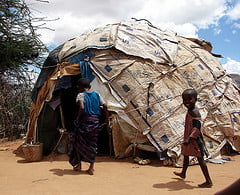East Africa is suffering its worst drought in 60 years and millions are streaming towards already crowded refugee camps. One of the largest, at Dabaab, was built in the early 90s for 90,000 refugees. Today the camp contains 400,000 people, making it the largest refugee camp in the world — and it is still growing. According to one source 1,000 new refugees are arriving in the camp per day. In response, the international community has pressured the Kenyan government to open a new refugee camp built in 2010. (Previously, the Kenyan government has blocked the camp from opening, fearing it would encourage more refugees to enter their country from Somalia.)
Even Al Shabaab, the Islamic rebel group battling for control of Somalia has acknowledged the danger of the drought and removed its ban on humanitarian organizations operating inside its territory. However, it is not that simple. Daveed Gartenstein-Ross and Tara Vassefi in The Atlantic argue that Al Shabaab might be able to use international aid in Somalia to further its battle against the government:
Shabaab’s propensity to extract economic gain from relief agencies also presents a challenge for U.S. policy. The U.S. has pledged $5 million to assist Somalis who have been struck by this drought. But, at the same time, U.S. policy is designed to prevent money from flowing to organizations like Shabaab, which has been named a Specially Designated Global Terrorist entity by the U.S. Treasury Department. Humanitarian organizations that provide money to such groups can face legal repercussions, even if it’s extracted from them unwillingly as a “tax.”
As Gartenstein-Ross and Vassefi point out, the desire of the international community to assist the millions in need in East Africa is undermined by the very real risk that the aid will help their enemies. Without the ability to guarantee that international aid will not flow into the hands of groups like Shabaab, governments might well be reluctant to provide the amount of aid necessary to assist the desperate millions living and dying in the Horn of Africa.
Photo credit: Bjørn Heidenstrøm
